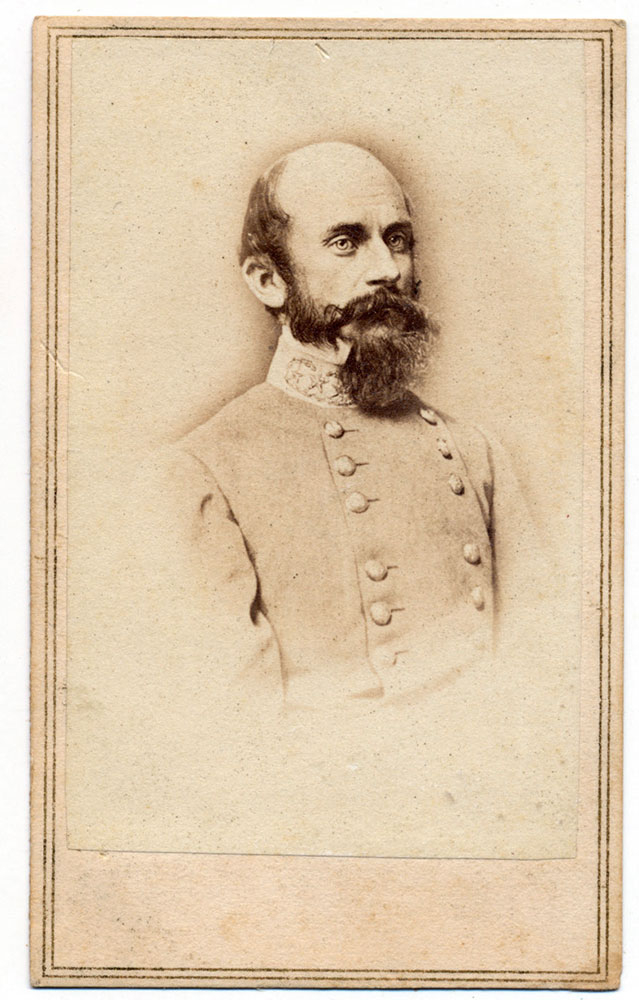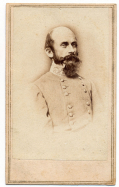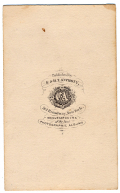site search
online catalog
WAIST-UP CDV OF CONFEDERATE GENERAL RICHARD S. EWELL WITH SEPARATE PERIOD INK NOTATION

$145.00 SOLD
Quantity Available: None
Item Code: 2022-1934
Image is of Ewell in Confederate uniform with general’s insignia clearly visible on his collar.
Contrast and clarity are very good. Mount and paper are also good.
Reverse has a photographer’s imprint for E. & H. T. ANTHONY… NEW YORK.
Also with the image is a slip of blue paper with a period ink inscription that reads “EWELL. HE HAS LOST A LEG & AN ARM.”
Richard Stoddart Ewell was born at Georgetown, D.C., February 8, 1817. He graduated from West Point in 1840, and was made a lieutenant of dragoons with whom he served on the frontier until 1846. He went into the Mexican war as first-lieutenant of Mason's Dragoons, participated in the fighting from Vera Cruz to Chapultepec and received the brevet of captain for gallantry at Contreras and Churubusco.
In 1849 he was promoted to captain, and continued in the United States service, on duty in New Mexico, until the spring of 1861, when he resigned his commission in order to tender his sword to Virginia. With the rank of lieutenant-colonel, corps of cavalry, he commanded the camp of instruction at Ashland, and was promoted brigadier-general June 17, 1861.
In command of the second brigade of the army of the Potomac under Beauregard he held the extreme right of the Confederate line during the first battle of Manassas.
He was promoted major-general in October, 1861, and given command of a division and ably led it during Jackson's famous campaign in the valley of the Shenandoah.
With his division Ewell defeated Banks at Winchester, May 25th, commanded on the field during the defeat of Fremont at Cross Keys, and during the final victory at Port Republic held Fremont in check and aided in the defeat of Tyler.
As senior major-general in Jackson's command, he participated in the subsequent battles before Richmond and was distinguished in the Manassas campaign of 1862, at the battle of Cedar Mountain, the capture of the Federal stores at Manassas Junction, and the engagement at Groveton, on the evening of August 28th, when he fell with a wound in the knee, which compelled the amputation of the leg.
Ewell returned to the army in May, 1863, and with promotion to the rank of lieutenant-general was assigned to the command of the Second Corps of the army of Northern Virginia, succeeding Stonewall Jackson, who had fallen at Chancellorsville.
He was in trusted with the important duty of clearing the Shenandoah valley of the Federals, which he executed in a brilliant manner, defeating the enemy at Brandy Station and Winchester, and occupying Harper's Ferry, capturing 4,000 prisoners and a large amount of arms and stores, with an aggregate loss of 269 men.
He then advanced into Pennsylvania reaching the Susquehanna River near Harrisburg. Here, he received orders to return to Cashtown. On the morning of July 1st, hearing of the advance toward Gettysburg, he turned his columns in that direction, and struck the Federal forces north of the village and drove them through the town, after which the Federals fell back to the position they subsequently defended. On the second day he made an unsuccessful attack on Culp's Hill, and renewed the fighting on the third day but was repulsed. In the years after Gettysburg Ewell became famous for his hesitation to assault Culp’s Hill on the night of July 1st.
On May 5, 1864, he was the first to engage with Grant's forces in the Wilderness, and after fighting stubbornly through that day, on the 6th he made a successful attack upon the Federal right wing. He bore the brunt of the terrible battle of the 12th at the " bloody angle," on the 18th severely repulsed the last Federal attack upon his position, and on the following day struck the left wing of the enemy, delaying Grant's turning movement for twenty-four hours.
During the fight at Spotsylvania, General Ewell's horse was shot under him, and he was so injured by the resulting fall that he could not continue in active service. He commanded the defenses of Richmond, and after the evacuation, in command of his corps took part in the action at Sailor's Creek, where he was made a prisoner. He was confined at Fort Warren for four months. Subsequently he made his home in Tennessee, and there passed away January 25, 1872.
Today he lies buried in Nashville City Cemetery, Nashville, Tennessee. [ad] [ph:L]
~~~~~~~~~~~~~~~~~~~~~~~~~~~~~~~~~~~
THIS ITEM, AS WITH ALL OTHER ITEMS AVAILABLE ON OUR WEB SITE,
MAY BE PURCHASED THROUGH OUR LAYAWAY PROGRAM.
CLICK HERE FOR OUR POLICIES AND TERMS.
THANK YOU!
Inquire About WAIST-UP CDV OF CONFEDERATE GENERAL RICHARD S. EWELL WITH SEPARATE PERIOD INK NOTATION
For inquiries, please email us at [email protected]
Most Popular
Historical Firearms Stolen From The National Civil War Museum In Harrisburg, Pa »
Theft From Gravesite Of Gen. John Reynolds »
Cavalry Carbine Sling Swivel »
Fine Condition Brass Infantry Bugle Insignia »
featured item
QUARTER-PLATE AMBROTYPE AND TWO LETTERS OF CONFEDERATE OFFICER RUNNELS DAVIS, WHO DIED OF WOUNDS RECEIVED AT THIRD WINCHESTER
Runnels Davis was born June 1, 1835. He was the first-born son of Alfred Ward Grayson Davis who was a roommate and third cousin, once removed, of future Confederate President Jefferson Davis at West Point. Alfred Davis left West Point before… (846-521). Learn More »





